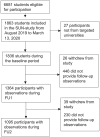Depression, anxiety and stress among Swedish university students before and during six months of the COVID-19 pandemic: A cohort study
- PMID: 34034577
- PMCID: PMC8521369
- DOI: 10.1177/14034948211015814
Depression, anxiety and stress among Swedish university students before and during six months of the COVID-19 pandemic: A cohort study
Abstract
Aims: The COVID-19 pandemic has had a profound effect on societies and citizens worldwide, raising concerns about potential mental health impacts. We aimed to describe trajectories of depression, anxiety and stress symptoms during the COVID-19 outbreak compared to before the outbreak, and to determine if trajectories were modified by pre-pandemic loneliness, poor sleep quality and mental health problems.
Methods: We conducted a cohort study with 1836 Swedish university students entering the study before 13 March 2020, the onset of the pandemic, with follow-ups within three (FU1) and six months (FU2) of the outbreak. Generalized Estimating Equations were used to estimate mean differences in symptom levels over time-periods, and to estimate potential effect modifications.
Results: We found small differences in mean levels of the depression, anxiety and stress scale (DASS-21) over time. Compared to before the pandemic, depression increased by 0.25 points of 21 (95% CI: 0.04 to 0.45) at FU1 and decreased by 0.75/21 (95% CI:-0.97 to -0.53) at FU2. Anxiety decreased from baseline to FU1 by 0.09/21 (95% CI: -0.24 to 0.07) and by 0.77/21 (95% CI: -0.93 to -0.61) to FU2. Stress decreased from baseline to FU1 by 0.30/21 (95% CI: -0.52 to -0.09) and by 1.32/21 (95% CI: -1.55 to -1.09) to FU2. Students with pre-pandemic loneliness, poor sleep quality or pre-pandemic mental health problems did not have worse trajectories of mean mental health symptoms.
Conclusions: Symptom levels were relatively stable during the first three months of the pandemic, while there was a slight decrease during the summer months, probably due to seasonality effects.
Keywords: COVID-19; Depression; Sweden; anxiety; coronavirus; mental health; stress; students.
Conflict of interest statement
Figures



Similar articles
-
Depression, anxiety and stress among Swedish university students during the second and third waves of COVID-19: A cohort study.Scand J Public Health. 2021 Nov;49(7):750-754. doi: 10.1177/14034948211031402. Epub 2021 Jul 24. Scand J Public Health. 2021. PMID: 34304621 Free PMC article.
-
Lifestyle behaviors in Swedish university students before and during the first six months of the COVID-19 pandemic: a cohort study.BMC Public Health. 2022 Jun 16;22(1):1207. doi: 10.1186/s12889-022-13553-7. BMC Public Health. 2022. PMID: 35710368 Free PMC article.
-
Factors Associated With Mental Health Disorders Among University Students in France Confined During the COVID-19 Pandemic.JAMA Netw Open. 2020 Oct 1;3(10):e2025591. doi: 10.1001/jamanetworkopen.2020.25591. JAMA Netw Open. 2020. PMID: 33095252 Free PMC article.
-
Anxiety and Depression in Chinese Students During the COVID-19 Pandemic: A Meta-Analysis.Front Public Health. 2021 Aug 17;9:697642. doi: 10.3389/fpubh.2021.697642. eCollection 2021. Front Public Health. 2021. PMID: 34485228 Free PMC article.
-
Impact of COVID-19 mitigations on anxiety and depression amongst university students: A systematic review and meta-analysis.J Glob Health. 2023 Sep 1;13:06035. doi: 10.7189/jogh.13.06035. J Glob Health. 2023. PMID: 37655370 Free PMC article.
Cited by
-
Stress, Anxiety and Depression Prevalence among Greek University Students during COVID-19 Pandemic: A Two-Year Survey.J Clin Med. 2022 Jul 22;11(15):4263. doi: 10.3390/jcm11154263. J Clin Med. 2022. PMID: 35893354 Free PMC article.
-
Loneliness in adolescence and prescription of psychotropic drugs in adulthood: 23-year longitudinal population-based and registry study.BJPsych Open. 2024 Mar 11;10(2):e61. doi: 10.1192/bjo.2024.22. BJPsych Open. 2024. PMID: 38465662 Free PMC article.
-
Symptoms of anxiety and depression among health and social science students: A multicenter study.Heliyon. 2025 Jan 15;11(2):e41957. doi: 10.1016/j.heliyon.2025.e41957. eCollection 2025 Jan 30. Heliyon. 2025. PMID: 39897836 Free PMC article.
-
COVID-19-related impact on mental health and career uncertainty in student-athletes-Data from a cohort of 7,025 athletes in an elite sport high school system in Sweden.Front Sports Act Living. 2022 Sep 20;4:943402. doi: 10.3389/fspor.2022.943402. eCollection 2022. Front Sports Act Living. 2022. PMID: 36203654 Free PMC article.
-
Impact of social isolation during the COVID-19 pandemic on the mental health of university students and recommendations for the post-pandemic period: A systematic review.Brain Behav Immun Health. 2024 Dec 24;43:100941. doi: 10.1016/j.bbih.2024.100941. eCollection 2025 Feb. Brain Behav Immun Health. 2024. PMID: 39845808 Free PMC article. Review.
References
-
- Ibrahim AK, Kelly SJ, Adams CE, et al.. A systematic review of studies of depression prevalence in university students. J Psychiatr Res 2013;47(3):391–400. - PubMed
MeSH terms
LinkOut - more resources
Full Text Sources
Other Literature Sources
Medical

